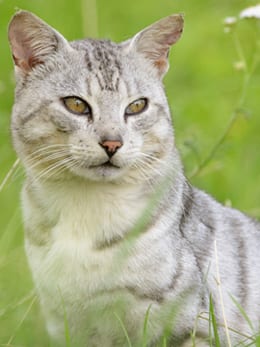10 Similarities Between Domestic Cats & Cats of the Wild

Despite a massive disparity in terms of size, location, and lifestyle, big cats and domestic cats are not as different as you might think. While you wouldn’t want to be trapped in the same room as a big cat, these giant predators have quite a lot in common with your small and seemingly harmless pet feline. Domesticated cats are believed to have descended from an ancient type of wildcat in Egypt and are said to be more closely related to the puma or lynx than the lion or tiger. Read on to learn more about the fascinating similarities between big cats and our cuddly domesticated friends.
10 Startling Similarities

- While lions and tigers don’t purr, pumas actually do! The hyoid bone attaches the larynx to the skull in domestic cats, while cartilage attaches the larynx to the skull in lions, thus allowing them to roar. Pumas on other hand purr just like domestic cats, though they are just a little bit louder!
- The next time your pet cat rubs up against you, bear in mind that he is actually ‘scent marking’ just like the big cats. The process of rubbing enables your cat to deposit the scent from its sebaceous glands onto you, thus marking you as part of its territory!
- When you scold your cat for ruining the table with his claws, remember that this is simply natural behavior also displayed by bigger cats. The giant cousins of your pet like to use visual markings, such as scratches on various items as another means of identifying their territory.
- Cats are nocturnal creatures, so this explains why your feline keeps you awake at night with his activities. Cats like to hunt at night and their amazing night vision and ability to hear noises at high frequencies gives them a distinct advantage over their prey.
- Domestic cats and big cats like to stalk their prey. Stealth is a key weapon for both. Big cats strike with lightning speed, use their claws to hold down captured prey, and finish things off with a bite to the vertebra. You will notice that domestic cats kill birds and rodents in a similar manner.
- All cats are meat eaters, so don’t subject your pet to a vegetarian diet! Simply put, your cat must eat food that contains meat in order for it to remain healthy, just like the big cats.
- The only type of cat that doesn’t have retractable claws is the cheetah, which has semi-retractable claws.
- All cats have four toes on their hind feet and five toes on their front feet.
- All cats have 38 chromosomes in each cell with two exceptions: the Geoffreys Cat and the Ocelot, which have two less with 36 chromosomes in each cell.
- All cats walk on their toes, with soft pads on the feet and toes to reduce the sound they make when walking. This padding also acts as protection, which is necessary when you consider how often cats run and jump.
Pet Trivia: Test Your Cat Knowledge with This Quiz
While your pet is part of the family, he still brings an element of the wild into your home. Yet your domestic cat is small, relatively harmless, and by most accounts… adorable!
